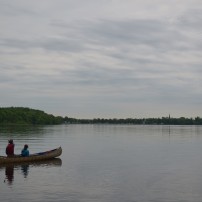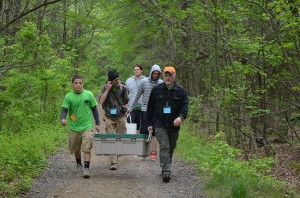Volunteer involvement ensures its success
View photos from the event HERE!
Heritage Conservancy kicked off its first ever BioBlitz at Bristol Marsh on Friday, May 17, in Bristol, PA. A BioBlitz is a 24-hour ecological survey during which teams work together to discover and document as many 
species of plant and animal life as possible to better understand an area’s ecosystem. The event brought together scientists, naturalists, students, teachers and community members to recognize the importance of biodiversity in the significant habitat of the Bristol Marsh Preserve.
Located along the Delaware River just southwest of the historic district of Bristol Borough of Bucks County, the Bristol March is a 33-acre natural area preserved by The Nature Conservancy and Bristol Borough and locally managed by Heritage Conservancy. The Preserve includes a rare and important freshwater tidal marsh, one of the few remaining in Pennsylvania.
Commencing on a beautiful spring afternoon, the opening ceremony of the BioBlitz featured speakers who welcomed the group of eager participants. The speakers included Jeffrey Marshall, President of Heritage Conservancy, Molly Anderson, Pennsylvania Volunteer Program Manager for The Nature Conservancy, Robyn Trunell, Council Vice President from Bristol Borough, and Justin Land, Public Affairs Manager for The Dow Chemical Company. Each speaker focused on a different aspect of the history of Bristol Marsh Preserve; together their messages culminated in an impactful speech that stressed the importance of volunteerism and the need for us all to collaborate as stewards to protect our planet.
With excitement for what discoveries laid ahead, participants set straight to work on surveying the marsh after the opening ceremony. When asked about what she was looking forward to finding in the marsh, Faith Seltzer, a student at Snyder-Girotti Middle School in Bristol, replied, “I’m excited about animals and aquatic insects.” Kayla Ruiz, a fellow student at Snyder-Girotti Middle School, concurred with Miss Seltzer. “I wanted to go on this trip to be outside and to see different creatures and living organisms. Also, aquatic insects.”
Around the clock for 24-hours, teams of volunteers ventured out into the marsh to find and identify as many species of plant and animal life they could find. The teams consisted of six areas of study that included birds, reptiles and amphibians, plants, mammals, insects and aquatics. Several of the teams monitored the marsh throughout Friday night, including the Mammalogy team, who documented native and migratory bats that fill crucial roles in our ecosystem.
Saturday’s weather brought clouds and rain, but that didn’t put a damper on anyone’s enthusiasm for the adventure of discovery. With a 30-foot net, the Aquatics team waded into the marsh at high tide to catch and document a slew of freshwater creatures. One of those creatures was an adorable Red-bellied turtle, a threatened species in Pennsylvania, which was later released back into the marsh. The Birding team took several trips into the marsh over the course of the 24 hours, each time listening and looking for new species undocumented from previous trips.
Saturday hosted a schedule of activities for the public to participate in as well. Hands-on discovery of the teams’ findings was a big attraction. Petri dishes full of plants and creatures looked quite impressive under the lens of a microscope. A large aquarium filled with fish and other aquatic species from the marsh was displayed for the public to view. A Skins and Skulls workshop displayed the hides and replica skulls of mammals found in our area. Another interesting workshop illustrated the different types of amphibians common to Pennsylvania.
 At the close of the Bristol Marsh BioBlitz, nearly 350 different species were discovered and documented. In the lead, an astounding 181 plant species, followed by 68 bird species, 50 insect species, 26 aquatics, 15 mammals and 6 amphibians and reptiles. The Water Pimpernel, a recommended threatened plant in Pennsylvania, and the Short-awned Foxtail, a recommended rare plant species in Pennsylvania, were among some of the significant findings. The large number of bird species identified shows that the marsh is rich in bird diversity. Many participants even caught sight of the nesting pair of Bald Eagles across the river and the resident osprey fishing and perching on the marsh’s trees.
At the close of the Bristol Marsh BioBlitz, nearly 350 different species were discovered and documented. In the lead, an astounding 181 plant species, followed by 68 bird species, 50 insect species, 26 aquatics, 15 mammals and 6 amphibians and reptiles. The Water Pimpernel, a recommended threatened plant in Pennsylvania, and the Short-awned Foxtail, a recommended rare plant species in Pennsylvania, were among some of the significant findings. The large number of bird species identified shows that the marsh is rich in bird diversity. Many participants even caught sight of the nesting pair of Bald Eagles across the river and the resident osprey fishing and perching on the marsh’s trees.
The findings from the BioBlitz will be used by Heritage Conservancy to make management decisions about how to best conserve and protect the natural resources within the Bristol Marsh Preserve Heritage Conservancy intends to host a BioBlitz at each of its ambassador properties in Bucks and Montgomery Counties to aid in the management of its preserved lands.
Heritage Conservancy’s local coordinator, Susan Myerov commented on the dedication of the volunteers. “I was so impressed by the work of our volunteer scientists, who brought their technical expertise and specialized equipment to both survey and record their findings. I was equally impressed by the local students who enthusiastically assisted the science teams and learned so much about scientific survey and recording methods.”
Heritage Conservancy thanks the staff at Bristol Borough and the Dow Chemical Company for their assistance in planning and during the entire event. A special thank you to all of the volunteers who dedicated their time to make the Bristol Marsh BioBlitz a success. As well, the exemplary adults who made sacrifices so that their children could partake in this event deserve commendation—their actions expressed the value of the BioBlitz to an impressionable younger generation. As the speakers at the opening ceremony stated, we all need to collaborate as stewards of the Earth. With a compassionate community working together, the Bristol Marsh BioBlitz brought these meaningful words to fruition.